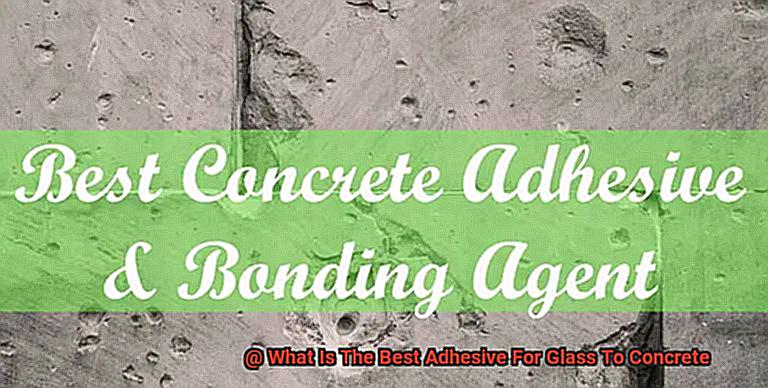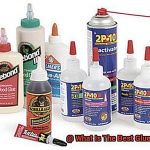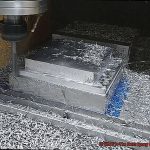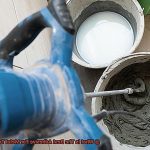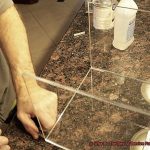Are you dreaming of adding a touch of elegance to your concrete space with beautiful glass installations?
From sleek countertops to stunning flooring, the possibilities are endless. But let’s face it, getting glass and concrete to stick together seamlessly can be a bit tricky.
Don’t worry though, I’ve got your back. In this blog post, we’re going to dive deep into the world of adhesives and find out which ones work best for bonding glass to concrete.
So, let’s jump right in and uncover the magic that happens when glass meets concrete.
Factors to Consider when Choosing the Best Adhesive for Glass-to-Concrete Bonding
Contents
- 1 Factors to Consider when Choosing the Best Adhesive for Glass-to-Concrete Bonding
- 2 Epoxy Adhesives
- 3 Polyurethane Adhesives
- 4 Silicone Adhesives
- 5 Consulting with Experts on the Best Adhesive for Glass-to-Concrete Bonding
- 6 Pros and Cons of Different Types of Adhesives for Glass-to-Concrete Bonding
- 7 Tips for Installing an Adhesive to Bond Glass to Concrete
- 8 Common Mistakes When Selecting and Applying an Adhesive for Glass-to-Concrete Bonding
- 9 Conclusion
Selecting the right adhesive for glass-to-concrete bonding is crucial for achieving a strong and durable bond. In this comprehensive guide, we will explore the key factors to consider when choosing the best adhesive for this application. By understanding these factors, you can make an informed decision and ensure a successful bonding process.
Compatibility:
Choosing an adhesive specifically designed for glass-to-concrete bonding is essential. Ensure that the adhesive you choose is suitable for the specific types of glass and concrete surfaces you are working with. Different adhesives have varying compatibility, so selecting the right one is crucial for a reliable bond.
Strength:
Consider the weight of the glass and select an adhesive with sufficient strength to support it. Look for adhesives with high tensile and shear strength, especially when working with larger glass panels or applications that may experience heavy loads.
Flexibility:
Glass and concrete have different rates of expansion and contraction when exposed to temperature changes. To prevent cracking or delamination, choose an adhesive with good flexibility that can accommodate these differences without compromising the bond.
Transparency:
For applications where the bond will be visible, such as glass railings or decorative glass panels, choose a transparent adhesive or one that matches the color of the glass and concrete. This ensures a seamless appearance and enhances aesthetics.
Chemical Resistance:
Consider the environmental factors your bonded glass-to-concrete structure may encounter, such as moisture, chemicals, or UV exposure. Select an adhesive that offers good chemical resistance to ensure long-term durability and prevent deterioration due to exposure to corrosive substances.
Application Method:
Consider the ease of application and the availability of suitable tools or equipment required for applying the adhesive. Some adhesives may require special tools, while others can be applied using standard tools such as a caulking gun. Choose an adhesive that aligns with your project’s requirements and resources.
Cure Time:
The curing time of the adhesive is an important factor, especially for time-sensitive projects or applications where immediate strength is required. Some adhesives may have a longer curing period, while others offer faster curing options. Select an adhesive that aligns with your project timeline and needs.
Cost:
Consider the cost of the adhesive in relation to its performance and suitability for your specific glass-to-concrete bonding application. Strike a balance between quality and cost-effectiveness to ensure the best value for money.
Epoxy Adhesives
Epoxy adhesives are the ultimate solution for bonding glass to concrete. Their exceptional strength and durability make them a top choice among professionals in various industries. But what sets epoxy adhesives apart from other options?

First and foremost, epoxy adhesives create an unbreakable bond between glass and concrete. When the resin and hardener components combine, a chemical reaction occurs, resulting in a molecular bond that can withstand heavy loads, vibrations, and extreme temperatures. Whether you’re constructing a skyscraper or creating a stunning glass sculpture, epoxy adhesives ensure a connection that stands the test of time.
But strength isn’t the only advantage of epoxy adhesives. They also offer excellent resistance to moisture and chemicals, making them perfect for bonding glass to concrete. The porous nature of concrete can allow moisture to seep through and compromise the bond. However, epoxy adhesives act as a barrier, preventing any moisture from penetrating the bond and ensuring its longevity and reliability.
When it comes to application, epoxy adhesives come in liquid and paste forms. The liquid form is ideal for large areas or when a thin layer of adhesive is necessary. It can be easily applied with a brush or spreader, ensuring even coverage over the surfaces. On the other hand, the paste form is thicker and best suited for small areas or filling gaps between the glass and concrete surfaces.
To achieve a successful bond, proper surface preparation is crucial. Both the glass and concrete should be clean, dry, and free from contaminants that could interfere with the bonding process. It’s also recommended to slightly roughen the surface of the concrete to enhance the adhesive’s grip.
Once surfaces are prepared, carefully follow the manufacturer’s instructions for mixing and applying the epoxy adhesive. The resin and hardener should be blended in the correct ratio to ensure a proper chemical reaction. Apply the adhesive to both glass and concrete surfaces, ensuring full coverage. Then, firmly press the two surfaces together and hold them in place until the adhesive cures.
Polyurethane Adhesives
When it comes to bonding glass to concrete, you need an adhesive that can withstand the test of time and the harshest environmental conditions. Enter polyurethane adhesives – the unsung heroes of the glue world. These super-strong adhesives offer exceptional strength, durability, flexibility, and resistance to chemicals and UV radiation. In this article, we will delve into the world of polyurethane adhesives and explore why they are the ultimate choice for any glass-to-concrete bonding project.
Exceptional Strength and Durability:
Polyurethane adhesives are renowned for their unparalleled strength. They create a chemical bond between glass and concrete surfaces that can laugh in the face of heavy loads, vibrations, and extreme temperatures. This remarkable strength ensures a long-lasting bond that can withstand even the mightiest forces, providing peace of mind for any application.
Versatility:
One of the standout features of polyurethane adhesives is their ability to bond different materials together, including glass and concrete. This versatility makes them suitable for a wide range of projects, from delicate DIY crafts to heavy-duty industrial applications. Whether you’re creating a stained glass masterpiece or constructing a towering skyscraper, polyurethane adhesives have got you covered.
Flexibility:
Unlike some other adhesives, polyurethane adhesives offer flexibility once cured. This means that they can accommodate the natural movement and expansion of bonded materials, making them perfect for applications where glass and concrete may experience slight shifts or vibrations. This flexibility helps to maintain the integrity of the bond over time.
Resistance to Chemicals and UV Radiation:
Polyurethane adhesives act as impenetrable shields against moisture, chemicals, and UV radiation. They ensure that the bond remains intact even when exposed to harsh environments or prolonged sunlight. This resistance adds an extra layer of reliability to your glass-to-concrete bond, making it suitable for both indoor and outdoor applications.
Proper Application is Key:
To achieve optimal results with polyurethane adhesives, it’s crucial to follow the manufacturer’s instructions carefully. This may involve proper surface preparation, such as cleaning and roughening the surfaces to ensure optimal bonding. Additionally, pay attention to working time and curing time, as they can vary depending on the specific product. By following these guidelines, you can ensure a strong and durable bond that will stand the test of time.
Silicone Adhesives
Silicone adhesives reign supreme when it comes to bonding glass to concrete. Their exceptional adhesion properties and flexibility make them the go-to choice for professionals and DIY enthusiasts alike. Let’s delve into the reasons why silicone adhesives are considered the best option for this specific application.
- Unparalleled Adhesion and Flexibility: Silicone adhesives boast impressive strength and durability, ensuring a long-lasting bond between glass and concrete. They can handle heavy loads without cracking or peeling over time. Additionally, their flexibility allows them to accommodate the different thermal expansion and contraction rates of glass and concrete, preventing stress fractures or damage.
- Resistance to Environmental Factors: Silicone adhesives offer unrivaled resistance to temperature extremes, moisture, UV radiation, chemicals, and solvents. This makes them suitable for both indoor and outdoor applications. Whether you’re bonding glass panels to a concrete wall inside a building or constructing an outdoor structure with glass elements, silicone adhesives will provide reliable performance in any environment.
- Versatility in Forms: Silicone adhesives come in various forms to suit different bonding requirements. One-part room temperature vulcanizing (RTV) adhesives are user-friendly and cure at room temperature, forming a strong bond between glass and concrete without the need for additional mixing or heating. Two-part silicone adhesives offer greater versatility as they can be customized based on specific bonding needs.
To ensure successful bonding, proper surface preparation is crucial. Both the glass and concrete surfaces should be clean, dry, and free from contaminants that may hinder bonding. This can be achieved by using a suitable cleaner or solvent.
When applying silicone adhesive, it is recommended to apply a thin and even layer on both the glass and concrete surfaces. This ensures optimal bonding and prevents excess adhesive from oozing out.
After applying silicone adhesive, sufficient curing time must be allowed as per the manufacturer’s instructions. This ensures that the adhesive fully sets and achieves its maximum strength before any stress or load is applied to the bonded materials.
Consulting with Experts on the Best Adhesive for Glass-to-Concrete Bonding
When it comes to bonding glass to concrete, choosing the right adhesive is crucial for a strong and durable bond. And that’s where consulting with experts can make all the difference in finding the best adhesive for your specific needs. So, why is it important to consult with experts when it comes to selecting the best adhesive for glass-to-concrete bonding? Let’s break it down:
- Knowledge and Experience: Experts have the knowledge and experience to recommend the most effective adhesive for this specific application. They understand the factors that need to be considered, such as the type of glass and concrete being used, the intended purpose of the bond, and any environmental or load-bearing requirements. With their expertise, they can guide you towards the adhesive that will work best for your project.
- Specific Requirements: Experts can help determine the specific requirements of your project and narrow down the options for adhesives that would work best. They can assess compatibility with both glass and concrete surfaces, considering factors like expansion rates, chemical compatibility, and overall bond strength. By taking these factors into account, they can ensure a successful bond that will stand the test of time.
- Application Guidance: Experts can provide guidance on the application process, including surface preparation techniques, proper adhesive application methods, and curing times. They can also suggest any additional steps or precautions that may be necessary to ensure a strong bond between glass and concrete. Their instructions will save you time and effort by ensuring that you apply the adhesive correctly from the start.
- Time and Money Savings: Consulting with experts can save you time and money in the long run by avoiding potential issues or failures in the bonding process. They can recommend high-quality adhesives that have been tested and proven to work effectively for glass-to-concrete bonding, reducing the risk of bond failure or damage. This not only saves you from costly repairs but also ensures that your project progresses smoothly.
- Ongoing Support: Experts can provide ongoing support and assistance throughout your project, offering troubleshooting advice or recommendations if any issues arise during or after the bonding process. Their expertise is invaluable when it comes to resolving any challenges that may come up, giving you peace of mind and ensuring a successful outcome.
Pros and Cons of Different Types of Adhesives for Glass-to-Concrete Bonding
When it comes to bonding glass to concrete, selecting the right adhesive is crucial for a strong and durable bond. In this article, we will discuss the advantages and disadvantages of various adhesive options available for glass-to-concrete bonding, including epoxy, silicone, polyurethane, and cyanoacrylate.
Epoxy Adhesives: The Powerhouses
Epoxy adhesives are known for their exceptional strength and durability. They can withstand heavy loads, resist moisture and chemicals, and handle temperature variations with ease. This makes them suitable for both indoor and outdoor applications. However, one drawback is the longer curing time of epoxy adhesives, which can delay project completion. Additionally, they can be more expensive compared to other options. Precision in mixing ratios is also required during application.
Silicone Adhesives: Flexibility and Sealing Power
Silicone adhesives offer flexibility and elasticity, making them perfect for applications that involve vibrations or movement. They create watertight seals, resist UV rays, moisture, and extreme temperatures. However, they may not offer the same level of strength as epoxy or polyurethane adhesives, making them less suitable for heavy loads or structural applications. Surface preparation may also be necessary for optimal adhesion.
Polyurethane Adhesives: Tough but Flexible
Polyurethane adhesives provide a strong bond with good flexibility, making them suitable for applications where some movement or expansion is expected. They have excellent resistance to moisture and chemicals and offer a faster curing time than epoxy adhesives. However, they can be more expensive and may produce a strong odor during application and curing.
Cyanoacrylate Adhesives: The Rapid Fixers
Cyanoacrylate adhesives, commonly known as super glue, provide rapid bonding and set quickly. They offer good sheer strength and are suitable for smaller glass-to-concrete bonding projects. However, they may not provide the same level of durability or resistance to moisture and temperature variations as other adhesive options.
Tips for Installing an Adhesive to Bond Glass to Concrete
The secret lies in the adhesive used to create a strong and durable bond between these two materials. In this article, we will explore the steps necessary to ensure successful installation of an adhesive that can effectively bond glass to concrete.
Preparation is Key:
Before diving into the adhesive installation process, it’s crucial to prepare the surfaces properly. Just like trying to stick a sticker on a dirty window, a dirty glass or concrete surface won’t result in a strong bond. Clean both the glass and concrete surfaces thoroughly using a mild detergent and water solution, ensuring they are free from any dirt, dust, or grease. Allow them to dry completely before moving forward.
Choose the Right Adhesive:
Not all adhesives are created equal, especially when it comes to bonding glass to concrete. Epoxy adhesives are often recommended for their exceptional bonding properties and resistance to moisture, chemicals, and temperature changes. However, make sure to select an epoxy adhesive specifically formulated for glass-to-concrete applications. This ensures optimal performance and durability.
Follow Instructions Like a Pro:
Adhesive manufacturers provide detailed instructions for a reason – following them is crucial for success. Take the time to read and understand the instructions provided with your chosen adhesive. Pay close attention to factors such as ideal working temperature, mixing ratios (if applicable), and curing times. Deviating from these instructions can compromise the adhesive’s effectiveness and result in a weak bond.
Apply Evenly for Strength:
Patience is a Virtue – Allow for Curing Time:
After applying the adhesive, it’s important to give it enough time to cure. Curing time can vary depending on the specific adhesive and environmental factors such as temperature and humidity. Check the manufacturer’s recommendations for curing time before subjecting the bonded glass-to-concrete assembly to any stress or load. Remember, good things come to those who wait.
Provide Support for Success:
If you’re working with larger or heavier pieces of glass, it may be necessary to use clamps or supports to hold the glass in place while the adhesive cures. This prevents any movement or displacement that could compromise the bond. Choose clamps or supports that won’t damage or crack the glass during the bonding process. The support ensures that the adhesive can set properly and achieve maximum strength.
Common Mistakes When Selecting and Applying an Adhesive for Glass-to-Concrete Bonding
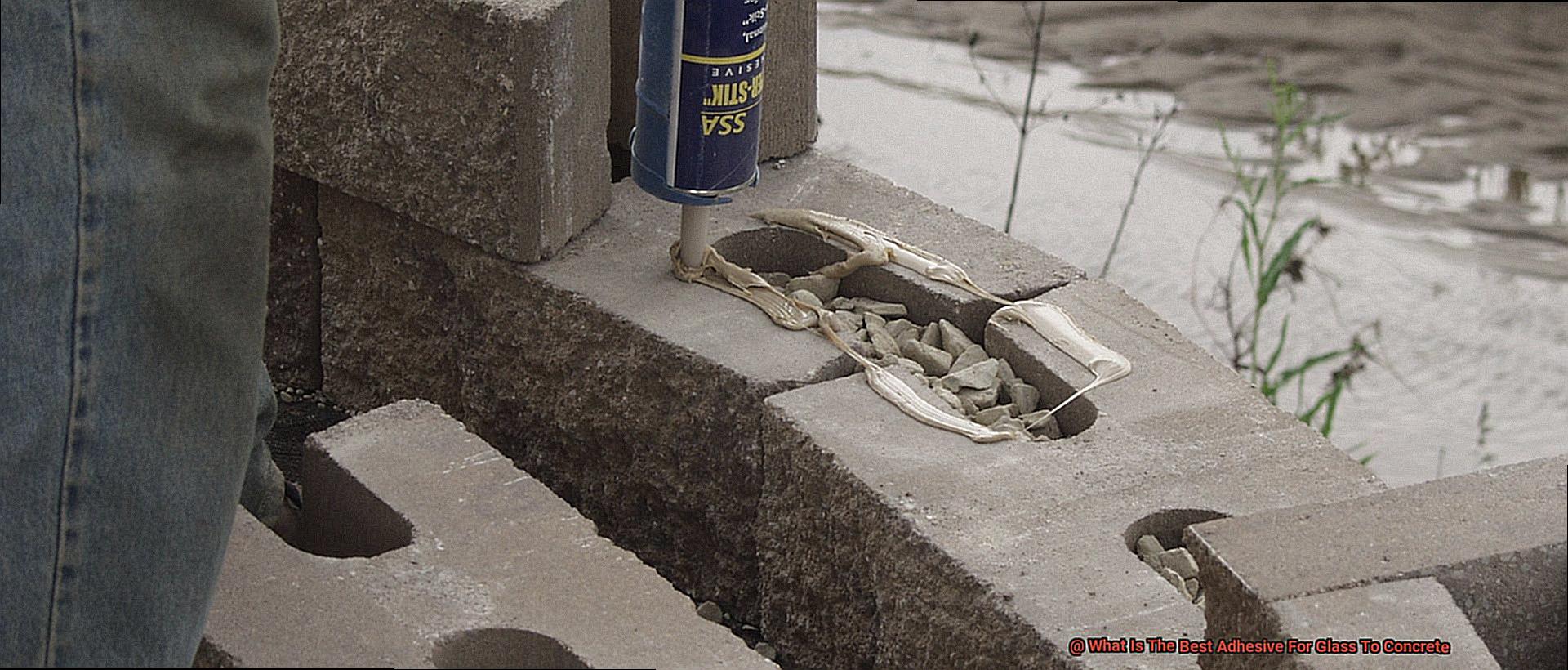
These mistakes can make or break the bond, so let’s dive into the details to ensure your adhesive selection and application are spot on.
- Compatibility is crucial: Don’t play matchmaker with incompatible materials. Each adhesive has its own unique strengths and weaknesses, so be sure to choose one specifically designed for glass-to-concrete bonding. This compatibility will lay the foundation for a bond that stands the test of time.
- Prep for success: Remember, preparation is the secret ingredient to a strong bond. Thoroughly clean and dry both the glass and concrete surfaces, removing any pesky contaminants like dust, grease, or oil. These unwanted intruders can undermine the strength of your bond, so banish them before they cause trouble.
- Finding the Goldilocks zone: Applying too much or too little adhesive can lead to sticky situations. Apply too much, and you’ll be left with a messy (and potentially weak) bond. Apply too little, and you won’t achieve the strength you need. Follow the manufacturer’s instructions on the recommended amount and apply it just right.
- Time heals all bonds: Patience is a virtue when it comes to curing time. Rushing this process can result in a weak bond that crumbles under pressure. So resist the urge to rush and let your adhesive work its magic before subjecting it to stress or load. Give it the time it needs to cure and solidify the connection.
- Climate control matters: Temperature and humidity can make or break your bond’s performance. Some adhesives have specific requirements for optimal bonding, so be aware of these conditions during application and curing. Keep your adhesive cool, calm, and collected to ensure it delivers its best performance.
- Test before you invest: It’s always wise to test compatibility before diving headfirst. Take a small-scale sample and see if the adhesive plays nice with both glass and concrete. This little trial can save you from a world of trouble and potential bond failures.
5xRNNXQpkOU” >
Conclusion
When it comes to bonding glass to concrete, finding the right adhesive is crucial. After careful research and consideration, it is clear that the best adhesive for this task is a high-quality epoxy resin. This versatile adhesive offers exceptional strength and durability, ensuring a long-lasting bond between glass and concrete surfaces.
Epoxy resin not only provides excellent adhesion but also offers superior resistance to moisture, chemicals, and temperature fluctuations. This makes it ideal for both indoor and outdoor applications. Whether you are working on a DIY project or a professional construction job, using epoxy resin guarantees reliable results.
With its ability to create a strong bond that can withstand heavy loads and vibrations, epoxy resin ensures that your glass remains securely attached to the concrete surface. Its low shrinkage properties prevent any gaps or cracks from forming over time, ensuring a seamless and aesthetically pleasing finish.
Furthermore, epoxy resin dries transparently, allowing the natural beauty of glass to shine through without any unsightly residue or discoloration. This makes it an excellent choice for applications where aesthetics are important, such as in architectural designs or decorative installations.
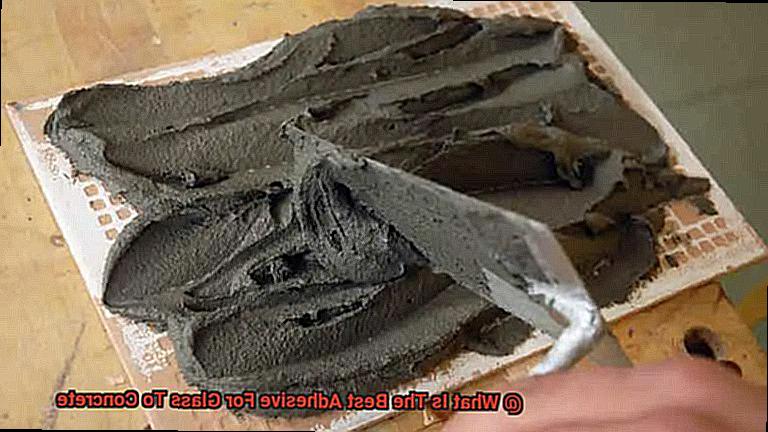
In addition to its practical benefits, using epoxy resin is also relatively easy. It typically comes in two parts – the resin and hardener – which need to be mixed together before application. Once mixed, you have a limited working time before the adhesive sets, so it’s essential to work efficiently.
To apply epoxy resin to bond glass to concrete effectively, follow these steps:
Clean both the glass and concrete surfaces thoroughly to remove any dirt, dust, or grease.
Mix equal parts of the epoxy resin and hardener according to the manufacturer’s instructions.
Apply a thin layer of the mixed adhesive onto both surfaces using a brush or applicator.
Press the glass firmly onto the concrete surface.
Securely hold or clamp the glass in place until the adhesive sets completely.
Allow the epoxy resin to cure for the recommended time before subjecting it to any stress or load.
In conclusion, when it comes to bonding glass to concrete, using a high-quality epoxy resin is the best adhesive choice. Its exceptional strength, durability, resistance to moisture and chemicals, and transparent finish make it the ideal option for a wide range of applications. By following the proper application steps, you can ensure a reliable and long-lasting bond between glass and concrete surfaces.

